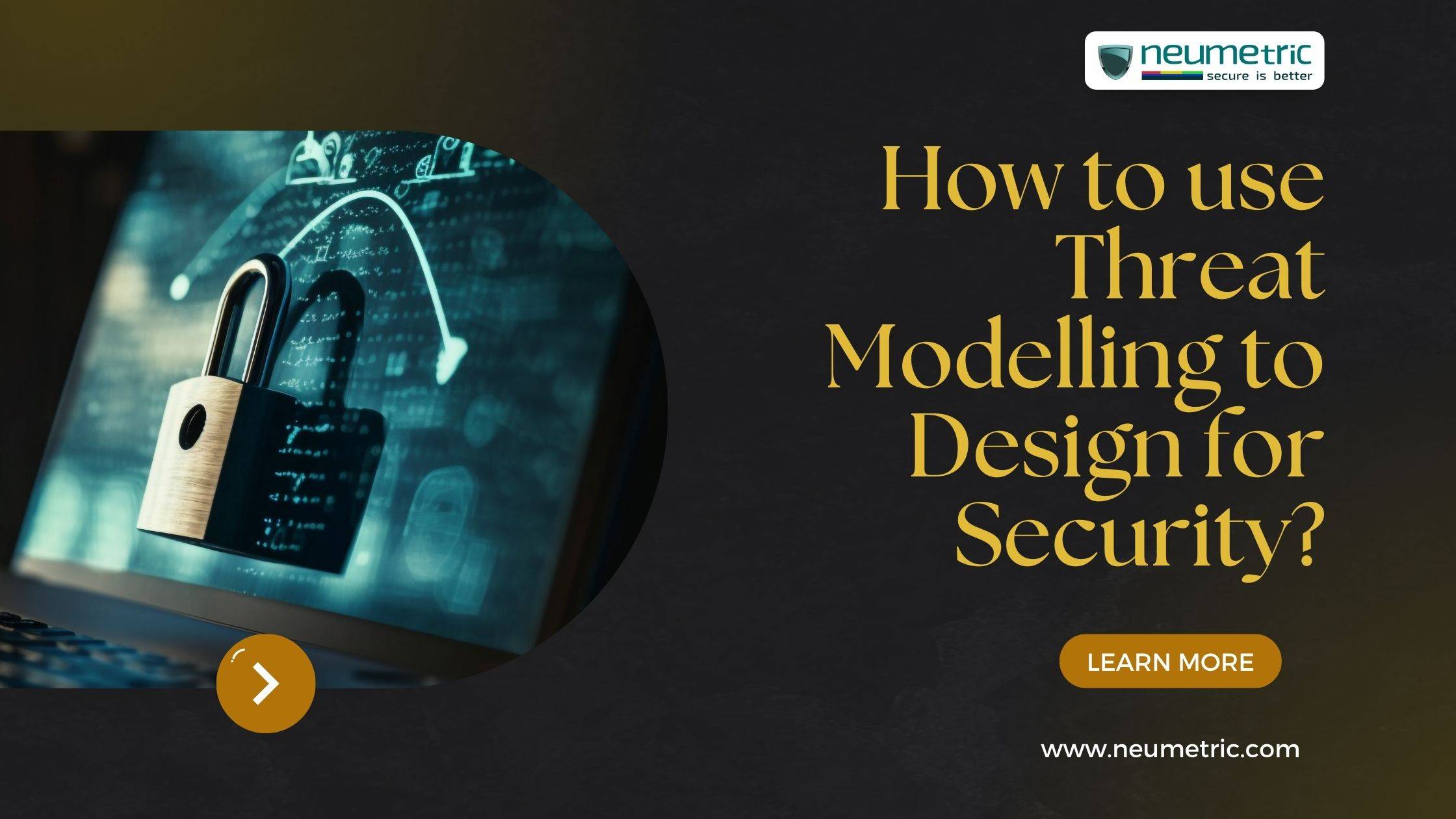Table of Contents
ToggleIntroduction
Threat modelling is a systematic & proactive approach to identifying, assessing, & mitigating potential security risks within a system, application or network. It involves the structured analysis of assets, both tangible & intangible, to ascertain their value & attractiveness to potential threats. Through categorising & profiling threats & conducting vulnerability analysis, the process aims to pinpoint weaknesses in the system early in the design & development phases, fostering a preemptive rather than reactive security strategy. As we delve deeper, we will explore the significance of integrating security into the design process, recognizing the contemporary security challenges that underscore the need for a paradigm shift from reactive to proactive security measures.
Understanding the scope of security within the context of threat modelling is crucial for developing a comprehensive & effective defence strategy. Security, in this context, extends far beyond traditional notions of protecting sensitive data; it encompasses a multifaceted approach to safeguarding the integrity, confidentiality, & availability of information, systems, & processes.
The role of threat modelling in the design process is pivotal, serving as a proactive foundation for creating resilient & secure systems from their inception. By integrating threat modelling into the early phases of design, organisations can systematically identify & address potential security risks, fostering a security-by-design approach that is fundamental in today’s complex digital landscape.
Understanding Threats
Types of Security Threats
a. External Threats: Examining risks originating from outside the system, such as cyberattacks or unauthorised access attempts.
b. Internal Threats: Investigating potential risks arising from within the system, including actions by employees or authorised users with malicious intent.
Threat Actors
a. Hackers: Assessing the motivations, capabilities, & techniques employed by external malicious actors.
b. Insiders: Recognizing the potential threats posed by individuals with insider knowledge, whether intentional or unintentional.
c. Competitors: Understanding the competitive landscape & potential risks associated with intellectual property theft or industrial espionage.
The Need for Threat Modelling
Identifying Vulnerabilities
a. Proactive Risk Identification: Emphasising the importance of identifying vulnerabilities before they are exploited.
b. Reducing Attack Surface: Minimising the potential points of entry for attackers through careful design & risk mitigation.
Proactive Security Measures
a. Preventing Security Incidents: Shifting from a reactive to a proactive stance in addressing security concerns.
b. Cost-Effective Security: Demonstrating how early threat identification & mitigation can save costs associated with incident response & recovery.
Key Components of Threat Modelling
A. Assets Identification
To fortify a system’s security, the initial step is a meticulous examination & classification of assets. These assets, whether tangible or intangible, serve as the building blocks of the digital landscape. By defining & valuing data assets such as sensitive information, intellectual property, & infrastructure components, organisations can lay the groundwork for a targeted threat modelling process.
B. Identifying Threats
Once assets are delineated, the focus shifts to recognizing potential threats that could compromise their integrity. This involves an in-depth analysis of external & internal factors, including the motivations of threat actors. By categorising & profiling threats, ranging from traditional cyberattacks to more nuanced insider threats, organisations can tailor their security measures to address specific risks.
C. Vulnerability Analysis
With assets & threats in focus, the next critical component is vulnerability analysis. This step involves identifying weaknesses within the system that threat actors might exploit. By conducting a comprehensive assessment of both known & potential vulnerabilities, organisations can proactively address weak points, reducing the risk of exploitation & fortifying the overall security posture.
Threat Modelling Techniques
A. STRIDE Framework
- Spoofing: Delving into the potential for identity deception & unauthorised access, assessing the susceptibility to impersonation & false authentication.
- Tampering: Evaluating the risks associated with unauthorised alterations to data or system components, focusing on data integrity & ensuring resistance against tampering attempts.
- Repudiation: Addressing concerns related to the denial of actions or events, emphasising the importance of traceability & accountability in system activities.
- Information Disclosure: Investigating vulnerabilities that may lead to the unauthorised exposure of sensitive information, emphasising the need for confidentiality safeguards.
- Denial of Service: Assessing the system’s resilience to denial-of-service attacks, ensuring that it can withstand attempts to disrupt or degrade its functionality.
- Elevation of Privilege: Analysing potential pathways for unauthorised users to escalate their privileges, focusing on maintaining the principle of least privilege.
B. DREAD Model
- Damage Potential: Quantifying the potential harm that could result from a successful exploitation of a vulnerability, ranging from minor inconveniences to severe consequences.
- Reproducibility: Evaluating how easily a vulnerability can be replicated by a threat actor, considering factors that may contribute to the widespread exploitation of the same vulnerability.
- Exploitability: Assessing the likelihood of a threat actor successfully exploiting a vulnerability, considering factors such as skill level & resources required.
- Affected Users: Identifying the scope of impact by determining the number & role of users who could be adversely affected by the exploitation of a vulnerability.
- Discoverability: Gauging how easily a potential vulnerability can be discovered by threat actors, considering factors such as visibility & public knowledge of the system.
To Use threat modelling effectively in designing for security
Identify Assets:
Begin by identifying and categorising the assets within your system. These can include sensitive data, intellectual property, and critical infrastructure components.
Recognize Potential Threats:
Consider both external and internal threats. External threats may come from hackers, while internal threats could involve employees with malicious intent. Profiling potential threat actors helps in anticipating and addressing specific risks.
Analyse Vulnerabilities:
Conduct a thorough analysis of vulnerabilities in your system. Assess both known and potential weaknesses that threat actors might exploit. This step is crucial for understanding where your system may be susceptible to attacks.
Choose a Threat Modelling Technique:
Select a suitable threat modelling technique that aligns with your organisation’s needs. Popular frameworks include the STRIDE model and the DREAD model. These frameworks provide structured approaches to identifying and prioritising threats.
Integrate into the Design Process:
Incorporate threat modelling early in the design process. Collaborate with cross-functional teams, including security experts, developers, and architects, to ensure a comprehensive analysis. This integration ensures that security considerations are embedded in the initial stages of development.
Utilise Threat Modelling Tools:
Leverage automated threat modelling tools or manual techniques, depending on your organisation’s preferences and capabilities. Tools like Microsoft’s Threat Modeling Tool or collaborative sessions like brainstorming can enhance the effectiveness of threat modelling.
Iterate and Update Regularly:
Recognize that threat modelling is an ongoing process. Regularly revisit and update threat models, especially during system changes or advancements in technology. This iterative approach ensures that security measures stay current and adaptive.
Align with Agile Practices:
Integrate threat modelling seamlessly into agile development practices. Align threat assessment sessions with sprint cycles to ensure security doesn’t hinder the agility of your development process.
Integrating Threat Modelling into the Design Process
A. Early Design Phases
Incorporating Security Requirements: The foundation of secure design lies in establishing explicit security requirements from the project’s inception. By defining security expectations early on, designers set the stage for a systematic approach to threat modelling.
Collaborative Design Sessions: Fostering cross-functional collaboration is essential. Inclusive design sessions that involve security experts, developers, architects, & other stakeholders enable a holistic perspective. Through collective brainstorming, potential threats & vulnerabilities are identified, laying the groundwork for subsequent analysis.
B. Iterative Process
Continuous Threat Assessment: Threat modelling is not a one-time event but an ongoing process. Regularly revisiting & reassessing potential threats ensures that security considerations remain up-to-date in the face of evolving technology & threat landscapes.
Adapting to Changes: In the dynamic realm of technology, change is inevitable. Whether it’s adopting new technologies or responding to emerging threats, threat modelling should be adaptable. Integrating changes seamlessly into the design process allows organisations to stay ahead in the ever-evolving landscape.
By weaving threat modelling into the fabric of the design process, organisations can instil a security-first mindset. This approach not only identifies & mitigates risks early on but also establishes a culture where security is an integral part of the design philosophy.
Tools for Threat Modelling
A. Automated Threat Modelling Tools
Microsoft Threat Modeling Tool: Microsoft’s tool provides a structured approach to identify threats & vulnerabilities in the design phase. It assists in creating threat models, documenting risks, & generating reports to facilitate collaboration among development teams.
OWASP Threat Dragon: An open-source threat modelling tool, OWASP Threat Dragon enables visual threat modelling & supports collaborative sessions. It assists in creating interactive threat models, helping teams to identify, prioritise, & mitigate potential risks.
B. Manual Threat Modelling Techniques
Brainstorming Sessions: Human intelligence is invaluable. Conducting collaborative brainstorming sessions involving security experts, developers, & architects allows for the collective exploration of potential threats & vulnerabilities.
Data Flow Diagrams: Visualising the flow of data within a system through diagrams aids in understanding potential points of vulnerability. Analysing data flow helps identify areas where sensitive information may be at risk & allows for the development of targeted security measures.
Challenges & Best Practices
A. Common Challenges in Threat Modelling
Resistance to Change: Overcoming resistance within organisations to adopt threat modelling can be challenging. Addressing misconceptions & highlighting the long-term benefits is crucial to fostering acceptance & integration.
Lack of Expertise: Inadequate understanding of threat modelling concepts & methodologies can hinder its effective implementation. Providing training & resources to team members helps bridge knowledge gaps & enhances the overall proficiency in threat modelling.
B. Best Practices for Effective Threat Modelling
Involvement of Cross-functional Teams: Threat modelling is most effective when it involves diverse perspectives. Collaborative efforts that include security experts, developers, architects, & other stakeholders bring a comprehensive understanding of potential threats & vulnerabilities.
Regular Training & Awareness: Continuous education on threat modelling concepts & evolving security landscapes is essential. Conducting regular training sessions ensures that team members are equipped to adapt their threat modelling strategies to changing environments.
By addressing these challenges & adhering to best practices, organisations can optimise their approach to threat modelling. Recognizing that effective threat modelling is not just a technical endeavour but a cultural shift, these insights will contribute to creating a resilient security framework that adapts to the ever-evolving threat landscape.
Future Trends in Threat Modelling
A. Evolving Threat Landscape
Automation & AI Integration: The integration of automation & artificial intelligence (AI) in threat modelling is expected to grow. Automated tools can assist in processing vast amounts of data, identifying patterns, & predicting potential threats, providing a more proactive & adaptive defence mechanism.
Quantum Computing Challenges: As quantum computing advances, threat modelling will face new challenges. The potential for breaking current encryption standards will necessitate innovative approaches to security, prompting a reevaluation of threat models to address quantum-related risks.
B. Integration with DevOps & Agile Processes
DevSecOps Integration: The convergence of development, security, & operations (DevSecOps) is becoming integral. Future threat modelling trends involve seamlessly integrating security into the DevOps pipeline, ensuring that security measures are not only proactive but also aligned with the rapid pace of development.
Agile Threat Modelling: Agile methodologies are gaining prominence, requiring threat modelling to adapt to shorter development cycles. Quick & iterative threat assessments aligned with agile processes will be essential to maintaining security without impeding development speed.
It becomes evident that threat modelling is not a static practice. It must evolve to meet the challenges of an ever-changing digital landscape. From leveraging cutting-edge technologies to adapting methodologies to agile frameworks, staying ahead of emerging threats requires a forward-thinking & dynamic approach to threat modelling.
Conclusion
In conclusion, threat modelling emerges as a proactive & strategic cornerstone in the realm of cybersecurity. It goes beyond a checklist exercise, embodying a holistic approach that spans from the early design phases to the integration of cutting-edge technologies. Recognizing the expansive scope of security & understanding the interconnected nature of assets, threats, & vulnerabilities, organisations can systematically fortify their digital ecosystems. The exploration of key components, techniques, & tools provides a comprehensive toolkit for identifying, assessing, & mitigating security risks, empowering organisations to embed a security-first mindset into their design philosophies.
The trends in automation, artificial intelligence, & the integration of threat modelling with agile methodologies illuminate the evolving landscape of security practices. By fostering a culture of collaboration, continuous learning, & proactive threat analysis, organisations position themselves not only to navigate the current threat landscape but to anticipate & mitigate the challenges that the future holds. In essence, threat modelling stands as a dynamic & essential practice, equipping organisations to build & maintain secure digital environments in an ever-changing cybersecurity landscape.
FAQ’s
What is threat modelling, & why does it matter?
Threat modelling is a method to identify & address security risks in digital systems early. It’s crucial to proactively protect sensitive data & ensure system resilience.
How can I start with threat modelling without being a cybersecurity expert?
Begin by categorising assets, understanding threats, & assessing vulnerabilities. User-friendly tools like Microsoft’s Threat Modeling Tool can guide you.
Is threat modelling beneficial for specific industries?
Yes, it’s valuable for any industry dealing with sensitive data or intellectual property, such as finance, healthcare or technology.
How often should we conduct threat modelling?
Regularly, especially during design phases & significant system changes, to stay aligned with evolving technologies & threats.
Can threat modelling fit into our agile development without slowing us down?
Absolutely! Integrate shorter, focused sessions aligned with sprint cycles to make security a seamless part of your agile development.





